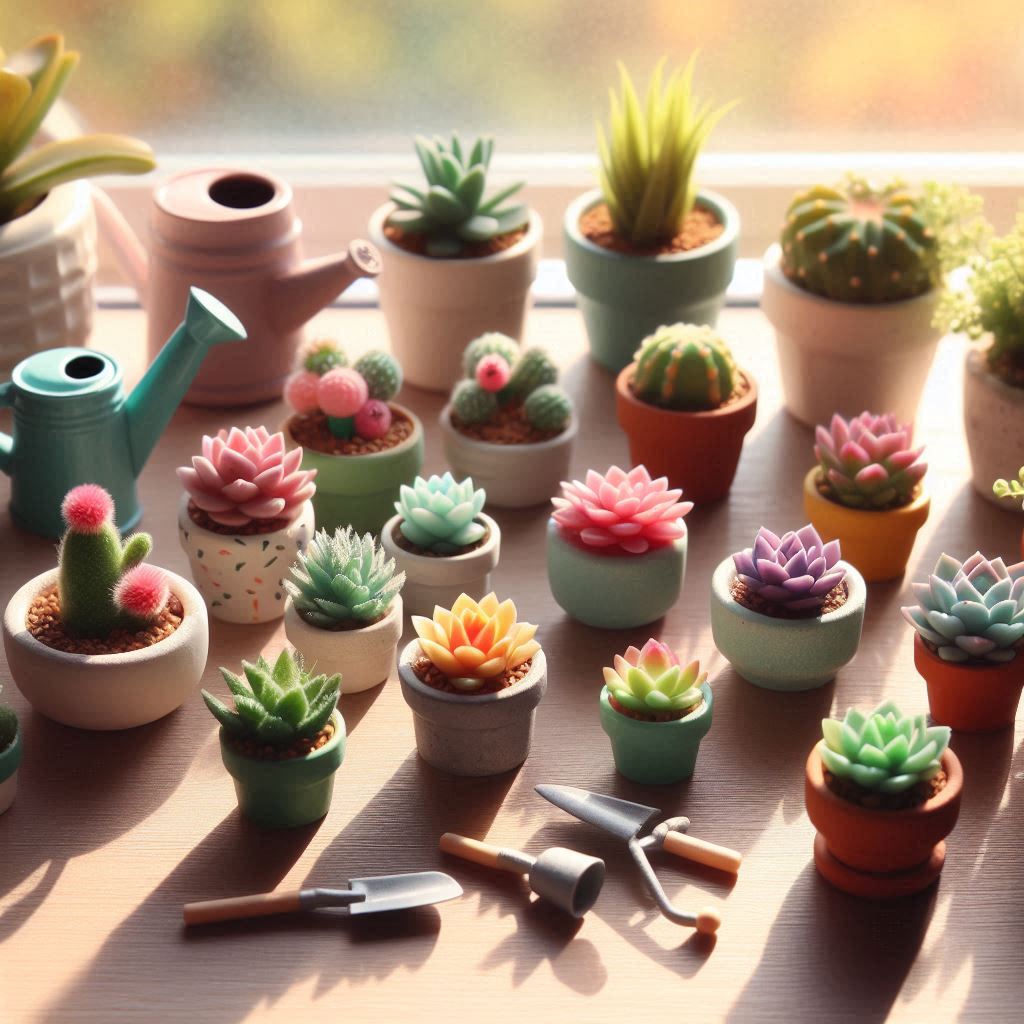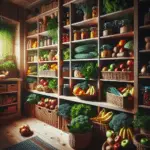Benefits of Growing Succulents Indoors
Succulents are not only trendy and visually appealing, but they also offer a plethora of benefits when grown indoors. Whether you’re a seasoned plant enthusiast or a beginner looking to liven up your space, incorporating succulents into your indoor environment can be incredibly rewarding.
1. Air Purification
Succulents, like many other houseplants, have the remarkable ability to purify the air by absorbing toxins and releasing oxygen. Having these plants indoors can contribute to creating a healthier living environment.
2. Low Maintenance
Succulents are well-known for their low maintenance requirements, making them perfect for busy individuals or those with limited gardening experience. These plants thrive on neglect, requiring minimal watering and care compared to other houseplants.
3. Stress Reduction
The presence of greenery has been linked to reduced stress and anxiety levels. Cultivating succulents indoors can provide a sense of calm and tranquility, serving as a natural stress-reliever in your daily life.
4. Versatility in Design
Succulents offer endless possibilities for creative interior design. From charming terrariums to elegant arrangements in pots and planters, these plants can enhance the aesthetic appeal of any room, adding a touch of nature to your decor.
5. Educational Experience
For families or individuals interested in learning more about plants and cultivation, growing succulents indoors can be an educational and rewarding experience. Observing their growth patterns and unique characteristics can be both fascinating and informative.
Low Maintenance Requirements
When it comes to growing succulents indoors, their low-maintenance nature makes them an ideal choice for both beginners and experienced gardeners alike. Below are some key points to consider:
Lighting Needs
Succulents thrive in bright, indirect light. Placing them near a sunny window or using a grow light can help maintain their health and vibrant colors.
Watering Frequency
Succulents are drought-tolerant plants that store water in their leaves and stems. It is crucial not to overwater them as it can lead to root rot. Wait until the soil is completely dry before watering again.
Well-Draining Soil
Using a well-draining soil mix specifically designed for succulents is essential. This helps prevent waterlogging, allowing the roots to breathe and reduces the risk of root diseases.
Temperature and Humidity
Succulents prefer warm temperatures and low humidity levels. Avoid placing them near drafty windows or areas with high moisture content to prevent issues like fungal growth.
Pest Control
Inspect your succulents regularly for any signs of pests such as mealybugs or spider mites. If detected, address the infestation promptly using natural remedies or insecticidal soap to protect your plants.
Ability to Thrive in Various Indoor Conditions
Succulents are renowned for their versatility and adaptability, making them ideal for indoor environments with diverse conditions. Whether you have a sunny window sill or a low-light office space, there is a succulent species that can thrive in your specific setting.
Key Factors Influencing Indoor Succulent Growth
- Light: Most succulents prefer indirect sunlight but can adapt to different light levels.
- Temperature: Succulents generally thrive in temperatures between 60-80°F but can tolerate fluctuations.
- Humidity: They prefer low humidity environments, making them perfect for indoor settings.
- Water: Succulents have low water requirements and are prone to rot if overwatered.
Choosing the Right Succulent for Your Space
Consider these factors when selecting succulents for indoor cultivation:
- Light Exposure: Match the plant’s light requirements with your indoor conditions.
- Space: Select succulents that fit the available space and growth habits.
- Temperature: Ensure the temperature range in your home aligns with the plant’s needs.
Quotes
“Succulents are like a piece of art that can adapt to any canvas, adding beauty to indoor spaces.” – Botanical Enthusiast
By understanding the needs of different succulent varieties and their ability to thrive in various indoor conditions, you can create a green oasis inside your home or workplace.
Enhancing Indoor Air Quality
Improving indoor air quality is essential for creating a healthy and rejuvenating environment within your home. By integrating appropriate strategies and careful plant selection, you can significantly enhance the air you breathe daily.
Choosing the Right Plants
- Opt for air-purifying plants such as aloe vera, snake plant, or spider plant.
- Consider the lighting and space requirements of each plant to ensure their optimal growth.
- Placement of plants in different areas of your home can contribute to overall air circulation.
Creating an Indoor Garden
Setting up a mini garden indoors not only adds aesthetic appeal but also serves as a natural air purifier.
Regular Maintenance
“Consistent care and maintenance are pivotal for plants to function efficiently as air purifiers.”
Regularly check for pests, prune damaged leaves, and ensure proper watering to maximize their air-filtering capabilities.
Avoiding Harsh Chemicals
Minimize the use of chemical cleaning agents and opt for natural and eco-friendly alternatives to prevent indoor air pollution.
Monitoring Air Quality
Invest in an air quality monitor to track pollutant levels and take necessary actions to improve the overall air quality indoors.
Choosing the Right Succulents for Indoors
When it comes to selecting succulents for indoor spaces, it’s essential to consider various factors to ensure their health and thriving growth. From light requirements to size considerations, each aspect plays a crucial role in determining the suitability of a succulent for your indoor environment.
Light Requirements
One of the primary considerations when choosing succulents for indoors is their light requirements. It’s essential to select succulents that can thrive in the lighting conditions available in your home. Here are some general guidelines:
- Succulents that thrive in bright light: Echeveria, Aloe Vera, Haworthia
- Succulents that can tolerate low light: Gasteria, Sansevieria, Haworthia
Size Constraints
Considering the size of the succulent is crucial, especially if you have limited space indoors. Some succulents grow tall, while others spread out. Here are some options based on size:
- Compact succulents: Crassula ovata (Jade Plant), Sedum dasyphyllum
- Tall succulents: Sansevieria (Snake Plant), Crassula arborescens
Succulent Arrangements
Creating visually appealing succulent arrangements can enhance the aesthetics of your indoor space. Consider mixing different succulent varieties to create a diverse and eye-catching display. Here are some tips:
- Vary textures: Combine succulents with different leaf shapes and textures for visual interest.
- Use contrasting colors: Pair succulents with complementary or contrasting colors for a striking arrangement.
Succulent Varieties Suited for Indoor Environments
1. Aloe Vera
Aloe Vera – Known for its soothing properties, this succulent is easy to care for and ideal for indoor settings. Its fleshy leaves store water, making it drought tolerant.
2. Echeveria
Echeveria – These rosette-shaped beauties come in a variety of colors and are perfect for bright indoor spots with adequate sunlight.
3. Haworthia
Haworthia – With striking rosettes and unique markings, Haworthia thrives in indirect sunlight, making it a great choice for indoor spaces.
4. Sedum
Sedum – Ideal for beginners, Sedum varieties like Sedum morganianum (Burro’s Tail) thrive indoors with minimal care.
5. Crassula
Crassula – From the classic Crassula ovata (Jade Plant) to the unique Crassula perforata (String of Buttons), these succulents add charm to any indoor space.
6. Kalanchoe
Kalanchoe – Known for its vibrant blooms, Kalanchoe blossfeldiana is a popular choice for indoor environments due to its low maintenance requirements.
7. Gasteria
Gasteria – Resilient and visually appealing, Gasteria species like Gasteria bicolor thrive in indoor conditions with moderate light.
8. Senecio
Senecio – Varieties such as Senecio rowleyanus (String of Pearls) are eye-catching and thrive in indoor spaces with bright, indirect light.
When selecting succulents for indoor growth, consider factors like light availability, watering needs, and the overall aesthetic you wish to achieve.
Factors to Consider When Selecting Indoor Succulents
Lighting Needs
One crucial factor to consider when choosing indoor succulents is their lighting requirements. Succulents generally thrive in bright, indirect light. Ensure you place them near a window where they can receive enough sunlight to flourish.
Watering Frequency
Each succulent species has different watering needs. Overwatering can be detrimental to succulents as they are adapted to survive in arid conditions. Research the specific watering requirements of the succulents you choose to prevent root rot.
Soil Quality
The type of soil is crucial for the health of indoor succulents. Use a well-draining soil mix specifically designed for succulents to prevent waterlogging. Adding perlite or sand can improve drainage and aeration.
Temperature and Humidity
Succulents prefer warm temperatures and low humidity levels. Keep indoor succulents away from drafty areas or extreme temperature fluctuations. High humidity can lead to fungal diseases, so ensure proper air circulation.
Space Availability
Consider the space where you plan to keep your succulents. Some succulents grow tall, while others spread out. Choose succulents that fit the available space and consider their growth habits to prevent overcrowding in the future.
Setting Up the Ideal Indoor Environment
Creating the perfect indoor environment for your succulents is crucial for their health and growth. By paying attention to key factors such as light, temperature, humidity, and airflow, you can provide the optimal conditions for your plants to thrive.
Lighting Requirements
Succulents require ample sunlight to photosynthesize and grow properly. Place your succulents near South-facing windows where they can receive indirect sunlight for at least 6 hours a day. If natural light is insufficient, consider using grow lights to supplement their light needs.
Temperature and Humidity
Maintaining the right temperature and humidity levels is essential for the well-being of your succulents. Most succulents thrive in warm and dry environments with temperatures ranging between 60°F to 80°F. Avoid placing them near drafty areas or vents that could expose them to extreme temperature fluctuations.
Airflow
Good air circulation is key to preventing issues such as mold or rot in your succulents. Ensure that there is proper ventilation in the room where your plants are located. You can use a fan on low setting to improve airflow without disturbing your plants too much.
Proper Lighting Conditions for Succulents
Proper lighting is essential for the health and growth of your indoor succulents. Understanding the lighting requirements for succulents will help you create an ideal environment for them to thrive.
Types of Light
Succulents require indirect bright light for at least six hours a day to grow well indoors. Here are the different types of light conditions to consider:
- Bright Indirect Light: Ideal for most types of succulents, placing them near a window or using sheer curtains to filter the light can help avoid direct sun exposure.
- Direct Sunlight: Some succulents can tolerate direct sunlight, but it’s crucial to monitor them to prevent sunburn.
- Low Light: While some succulents can survive in low light conditions, they may not thrive or grow as well as they would in brighter light.
Lighting Tips
Here are some tips to ensure your succulents receive adequate light:
- Rotate Frequently: Rotating your succulents regularly helps ensure all sides receive equal light exposure, preventing them from leaning towards the light source.
- Monitor Sun Exposure: Keep an eye on your succulents to ensure they are not getting sunburned. If the leaves start turning brown or translucent, consider moving them to a spot with less direct sunlight.
- Artificial Lighting: If natural light is limited, consider using grow lights specifically designed for plants to supplement their light requirements.
Remember, finding the right balance of light for your succulents is key to their overall well-being. Observing their behavior and making adjustments accordingly will help them thrive indoors.
Temperature and Humidity Considerations
When cultivating succulents indoors, it is crucial to pay attention to temperature and humidity levels to ensure the well-being and thriving growth of these resilient plants.
Temperature
- Optimal Range: Most succulents prefer temperatures between 60°F and 80°F (15°C to 27°C) during the day.
- Night Temperatures: Succulents generally tolerate cooler temperatures at night, with a range of 50°F to 55°F (10°C to 13°C).
- Avoid Extreme Heat: Shield your succulents from excessive heat sources such as radiators or direct sunlight to prevent damage.
Humidity
- Low Humidity: Succulents thrive in low humidity environments, making them well-suited for indoor conditions.
- Misting: In dry climates, occasional misting can provide a slight increase in humidity, but avoid over-spraying to prevent rot.
- Air Circulation: Ensure good air circulation around your succulents to prevent stagnant moisture, which can lead to fungal issues.
Selecting the Right Containers and Soil for Indoor Succulents
Choosing Appropriate Containers
When selecting containers for your indoor succulents, consider both functionality and aesthetics. Here are some key points to keep in mind:
- Drainage is Essential: Opt for containers with drainage holes to prevent waterlogging, which can be detrimental to succulents.
- Material Matters: Porous materials like terracotta allow better airflow to the roots, aiding in preventing overwatering.
- Size and Space: Ensure the container is large enough to accommodate the succulent’s roots and leave some room for growth.
Understanding the Right Soil Mix
The right soil mix is crucial for the health and growth of indoor succulents. Here’s what you need to know:
Succulent-Specific Mix: Opt for a well-draining soil mix specifically formulated for succulents and cacti.
Avoid Compaction: Look for soil mixes that are light and airy to prevent compaction and enhance drainage.
DIY Mix: If desired, you can create your own succulent soil mix by combining sand, perlite, and potting soil in the right proportions.
Watering and Maintenance Tips
Proper Watering Techniques
When it comes to watering your indoor succulents, balance is key. Overwatering can lead to root rot, while underwatering can cause the plants to wither. Here are some essential watering tips:
- Ensure proper drainage: Use pots with drainage holes to prevent waterlogging.
- Water sparingly: Succulents prefer to dry out between waterings. Check the soil moisture before watering again.
- Water at the base: Direct water at the base of the plant to avoid getting the leaves wet, which can cause rot.
Frequency of Watering
The frequency of watering your indoor succulents depends on various factors including the type of succulent, humidity levels, and pot size. As a general rule:
“Water when the top inch of the soil is dry.”
Signs of Under/Overwatering
Understanding the signs of under or overwatering can help you adjust your watering habits:
- Underwatered succulents may have wrinkled or shriveled leaves and appear dry.
- Overwatering can cause yellowing leaves, mushy stems, or fungus growth.
Maintenance Tips
Aside from watering, proper maintenance is crucial for the health of your indoor succulents. Here are some maintenance tips to keep your plants thriving:
- Provide Adequate Light: Place your succulents near a sunny window or provide artificial grow lights if natural light is limited.
- Monitor Temperature: Succulents prefer temperatures between 60-80°F (15-27°C).
- Rotate the Plants: Rotate your succulents regularly to ensure even growth and prevent leaning towards the light source.
- Clean the Leaves: Use a soft brush to gently remove dust from the leaves to allow for better light absorption.
Understanding Succulent Watering Needs
Properly understanding the watering requirements of your succulents is crucial to their health and growth. Here, we delve into the essential aspects to consider when watering these unique plants.
Frequency of Watering
Succulents have a low water requirement due to their ability to store water in their leaves and stems. Overwatering can lead to root rot, while underwatering can cause dehydration. Finding the right balance is key.
Signs of Overwatering
- Yellowing or transparent leaves
- Soft, mushy stems
- Foul odor
Signs of Underwatering
- Wrinkled or shriveled leaves
- Slow or no growth
- Leaves falling off
Best Practices for Watering
Water deeply but infrequently to encourage deep root growth. Ensure the soil completely dries out between waterings to prevent issues related to excess moisture.
Testing Soil Moisture
Use a moisture meter or simply stick your finger into the soil. If it feels dry an inch deep, it’s likely time to water. Remember, it’s better to underwater than overwater succulents.
Seasonal Adjustments
During the growing season, typically spring and summer, succulents may need more frequent watering. In winter months, reduce watering to adapt to their dormant period.
Tips for Preventing Overwatering
Overwatering is one of the most common issues that can harm your indoor succulents. Here are some valuable tips to help you prevent overwatering and ensure the health and vitality of your plants.
1. Understand Your Plant’s Watering Needs
Each succulent species has its own watering requirements. Research each plant’s specific needs to determine how often and how much water your succulents need.
2. Use Well-Draining Soil
Plant your succulents in well-draining soil to prevent water from pooling at the roots. A mix designed for succulents and cacti is ideal to promote proper drainage.
3. Allow Soil to Dry Between Waterings
Ensure the soil is completely dry before watering again. Insert your finger into the soil about an inch deep; if it feels dry, it’s time to water.
4. Opt for a Watering Schedule
Create a consistent watering schedule based on your succulents’ needs. Stick to the schedule to avoid the temptation of overwatering.

5. Monitor the Signs of Overwatering
Look out for signs such as yellowing or translucent leaves, which indicate overwatering. Adjust your watering habits accordingly to prevent damage.
6. Choose the Right Pot
Select pots with drainage holes to allow excess water to escape. This helps prevent water from accumulating at the bottom of the pot and causing root rot.
By following these essential tips, you can effectively prevent overwatering and foster a thriving indoor succulent garden.
Pruning and Grooming Techniques for Healthy Succulents
Importance of Pruning
Pruning is a crucial aspect of succulent care that helps promote a healthier and more attractive plant. By removing dead or overgrown parts, you can improve air circulation, prevent diseases, and encourage new growth.
Tools for Pruning
When pruning your succulents, it’s essential to use the right tools to ensure clean cuts and minimize damage. Some common tools include sharp scissors, pruning shears, and a clean knife or blade for tougher stems.
Basic Pruning Techniques
- Remove Dead Leaves: Gently twist or cut off any dead or dried leaves at the base of the plant to prevent rot.
- Trim Leggy Growth: Cut back leggy or elongated stems to encourage a more compact and bushy shape.
- Pinch Off Flower Stalks: If your succulent has finished flowering, snip off the flower stalk to redirect energy back into the plant.
Grooming Tips
Grooming your succulents goes beyond just pruning. Regular grooming practices can help maintain their overall health and appearance.
Monitoring for Pests and Diseases
Keep a close eye on your succulents for any signs of pest infestations or disease. Early detection can prevent serious damage to your plants.
Quote:
“Regular pruning and grooming not only benefit the plant but also provide a therapeutic experience for the caretaker.”
Cleaning Pruning Tools
After each use, make sure to clean your pruning tools with a mix of water and mild soap to prevent the spread of bacteria or diseases between plants.
Proper Disposal of Trimmings
Dispose of any pruned or trimmed parts properly to avoid attracting pests or spreading diseases. Composting or sealing them in a bag for trash disposal are common methods.
Dealing with Common Succulent Growing Issues
1. Overwatering
One of the most common issues with growing succulents indoors is overwatering. Excessive watering can lead to root rot and eventual plant death. To prevent this:
- Ensure your succulents are planted in well-draining soil.
- Water only when the top inch of soil is dry.
- Avoid leaving standing water in the saucer beneath the pot.
2. Sunburn
Too much direct sunlight can cause sunburn on your succulents, leading to bleached or brown spots on the leaves. To remedy and prevent sunburn:
- Gradually introduce your succulents to direct sunlight to acclimate them.
- Provide afternoon shade during the hottest hours of the day.
- Consider moving the plants to a spot with filtered sunlight.
3. Pest Infestations
Succulents are susceptible to pests such as mealybugs, spider mites, and aphids. To combat pest infestations:
- Inspect your plants regularly for any signs of pests.
- Isolate infected plants to prevent the spread of pests to others.
- Treat the infested plants with organic insecticidal soap or neem oil.
4. Leggy Growth
Leggy growth occurs when succulents stretch out in search of more light. To prevent leggy growth:
Ensure your succulents receive adequate sunlight to encourage compact growth.
5. Root Bound Succulents
When the roots outgrow the pot, succulents become root-bound, leading to stunted growth. Here’s how to address root-bound succulents:
- Repot your succulent into a slightly larger container.
- Loosen the roots gently before transferring to the new pot.
- Refresh the soil to provide the plant with necessary nutrients.
Recognizing Signs of Pests and Diseases
Keeping a keen eye on your succulents is crucial for their well-being. Recognizing early signs of pests and diseases can help you address issues promptly, safeguarding the health of your indoor garden.
Common Pests
- Aphids: Small, pear-shaped insects that cluster on new growth.
- Mealybugs: White, cottony pests found in leaf axils and on stems.
- Spider Mites: Tiny pests that create fine webbing on plants.
Identifying Disease Symptoms
Look out for the following signs of potential diseases: Rot – Soft, discolored, or mushy areas on the plant. Mold or Mildew – Powdery substance on the leaves or stems. Leaf Spot – Circular colored spots on the leaves.
Visual Inspections
Regularly examine your succulents for any of the aforementioned symptoms. It’s recommended to check both the upper and lower surfaces of the leaves, as well as the stems and soil for any abnormalities.
Preventive Measures
Implement preventive strategies such as:
- Quarantine: Isolating new plants before introducing them to your collection.
- Adequate Air Circulation: Promoting airflow around plants to deter pests and diseases.
- Proper Watering: Avoiding overwatering to prevent root rot and fungal issues.
By staying vigilant and taking proactive steps, you can maintain the health and vitality of your indoor succulent garden.
Strategies for Pest and Disease Prevention
Keeping your indoor succulents healthy involves more than just proper watering and sunlight. Preventing pests and diseases is crucial to ensure your plants thrive. Here are some strategies to help you maintain a pest and disease-free environment for your beloved succulents:
1. Monitoring and Inspection
- Regularly inspect your succulents for any signs of pests or diseases, such as discoloration, unusual spots, or webbing.
- Act promptly upon noticing any abnormalities to prevent the spread of infestations.
2. Proper Air Circulation
Ensure adequate air circulation around your succulents to reduce the risk of fungal diseases that thrive in stagnant air.
3. Quarantine New Additions
Before introducing new succulents to your indoor collection, quarantine them for a few weeks to observe and prevent any potential pest or disease issues from spreading to your existing plants.
4. Natural Remedies
“Integrate organic methods such as neem oil or diluted soapy water to deter common pests like aphids or spider mites without harming your succulents.”
5. Soil Maintenance
- Use well-draining soil to prevent waterlogged conditions that can lead to root rot and fungal diseases.
- Replace the soil periodically to refresh nutrients and reduce the risk of pest infestations.
6. Balanced Watering
Practice proper watering techniques to avoid attracting pests like fungus gnats that thrive in overly moist environments.
7. Pruning and Sanitizing
Regularly prune dead or decaying parts of your succulents and sanitize your tools to prevent the spread of diseases between plants.
8. Observing Plant Behavior
Pay attention to any changes in your succulents’ growth patterns or appearance as early detection of issues can help in proactive pest and disease management.
By implementing these strategies, you can create a robust defense system to protect your indoor succulents from pests and diseases, fostering a thriving and vibrant plant environment.
Troubleshooting Common Succulent Care Problems
Succulents, while resilient, may encounter various care issues that could affect their growth and overall health. Here are some common problems you might face when caring for indoor succulents:
1. Overwatering
Signs: Yellowing or translucent leaves, mushy stems, and a musty smell.
Solution: Allow the soil to dry completely between waterings and adjust your watering schedule.
2. Underwatering
Signs: Wrinkled or shriveled leaves, dry and crispy texture, and slow growth.
Solution: Increase the frequency of watering, ensuring the soil is evenly moist but not waterlogged.
3. Insufficient Light
Signs: Leggy growth, pale or faded leaves, and a stretching appearance.
Solution: Place your succulents in a location with bright, indirect sunlight or supplement with grow lights.
4. Pest Infestation
Signs: Tiny bugs on the plant, webbing, or stippling on leaves.
Solution: Identify the pest and treat with neem oil or insecticidal soap following the instructions carefully.
5. Root Rot
Signs: Blackened or mushy roots, a foul smell from the soil, and wilting despite sufficient water.
Solution: Remove the affected plant from the soil, trim away rotting roots, and replant in fresh, well-draining soil.
Remember, prevention and early detection are key to keeping your indoor succulents thriving. By addressing these common care problems promptly, you can ensure your succulent collection remains healthy and beautiful.
Propagation Techniques for Indoor Succulents
When it comes to propagating indoor succulents, there are several techniques you can employ to ensure successful growth and expansion of your succulent collection. Understanding the key methods of propagation can enhance your gardening skills and lead to a thriving indoor succulent garden.
1. Leaf Cuttings
One of the most common and effective methods of propagating succulents is through leaf cuttings. Follow these steps:
- Select a healthy leaf from the parent plant.
- Allow the leaf to air dry for a day or two until a callus forms at the cut end.
- Place the leaf on well-draining soil and mist occasionally.
- Within a few weeks, roots and new growth should appear.
2. Stem Cuttings
Another reliable method is using stem cuttings:
- Take a cutting from a healthy, mature stem with a clean, sharp knife.
- Let the stem cutting dry for a couple of days to prevent rot.
- Plant the stem in a succulent mix and lightly water.
- Roots will develop, and a new plant will form over time.
3. Offsets or Pups
Offsets or pups are small plantlets that grow at the base of mature succulents. Here’s what you can do:
- Gently remove the offset from the parent plant using a clean, sharp tool.
- Allow the offset to dry for a day to prevent rotting.
- Plant the offset in well-draining soil and water sparingly.
- With proper care, the offset will establish roots and continue to grow.
4. Division
For succulents that have multiple rosettes or stems clustered together, division can be a useful propagation technique:
- Carefully separate the different rosettes or stems from the main plant.
- Allow the cuttings to dry out before planting them in their individual pots.
- Water lightly and provide adequate sunlight for the divided plants to thrive.
By utilizing these propagation techniques, you can expand your indoor succulent collection and enjoy the process of nurturing new plants from existing ones.
Methods of Propagating Succulents Indoors
1. Propagation through Leaves
One common method of propagating succulents indoors is through leaf cuttings. This involves carefully removing a healthy leaf from the parent plant and allowing it to callus before planting it in a well-draining soil mix.
2. Propagation through Offsets
Offsets, also known as pups or babies, are small plants that grow at the base of the parent succulent. These can be gently removed and planted separately to grow into new plants.
3. Propagation through Stems
Stem cuttings are another effective way to propagate succulents indoors. By taking a cutting of the stem and allowing it to dry and callus, you can then plant it in soil to root and develop into a new plant.
4. Propagation through Division
Some succulents can be propagated through division, where the plant is carefully divided into smaller sections, each with roots attached. These sections can then be replanted to grow into individual plants.
5. Additional Tips for Successful Propagation
- Ensure the cuttings or divisions are allowed to callus before planting to prevent rotting.
- Use a well-draining soil mix specifically formulated for succulents to ensure proper root development.
- Place the newly propagated plants in a location with bright, indirect sunlight to promote growth.
- Water sparingly after planting to avoid overwatering, which can be detrimental to succulents.
Tips for Successful Succulent Propagation
Propagating succulents can be a rewarding experience, allowing you to expand your collection and share these beautiful plants with others. To ensure successful propagation, follow these essential tips:
1. Choose the Right Method
There are various methods to propagate succulents, including leaf cuttings, stem cuttings, and division. Select the method that is most suitable for the specific succulent species you are working with.
2. Use Well-Draining Soil
When propagating succulents, it is crucial to use a well-draining soil mix to prevent overwatering and root rot. Consider a mix of potting soil and perlite for optimal results.
3. Provide Adequate Light
Succulents thrive in bright, indirect light. Place your propagated cuttings in a location where they can receive adequate sunlight without being exposed to direct, intense rays.
4. Monitor Watering Carefully
During the propagation process, avoid overwatering the succulents. Allow the soil to dry out between watering sessions to promote healthy root development and prevent issues such as mold or fungus.
5. Be Patient
Propagation takes time, and not all cuttings will successfully root. Exercise patience and give your succulents the time they need to establish themselves and grow into healthy plants.
6. Protect from Pests
Keep a close eye on your propagated succulents for any signs of pests, such as mealybugs or aphids. Use natural remedies or insecticidal soap to control infestations and protect your plants.
By following these tips and providing the necessary care, you can increase your chances of successful succulent propagation and enjoy watching new plants grow and thrive in your indoor garden.
Creative Indoor Succulent Display Ideas
When it comes to displaying your indoor succulents, there are numerous creative ideas that can enhance the beauty of your space. Here are some inspiring ways to showcase your succulents:
Suspended Gardens
Hang your succulents in macrame plant hangers near windows or in well-lit areas to create an eye-catching suspended garden.
Miniature Terrariums
Create miniature succulent terrariums using glass containers or bowls. These encapsulated gardens add a touch of elegance to any room.
Vertical Wall Planters
Utilize vertical wall planters to maximize space and bring a lush greenery element to your walls. Succulents look stunning when arranged vertically.
Repurposed Containers
Gather unique containers like teacups, vintage tins, or old books to plant your succulents. Repurposing items adds a personalized and whimsical touch to your display.
Succulent Centerpieces
Create succulent centerpieces by arranging a variety of succulents in a shallow tray or decorative bowl. These make striking focal points on dining tables or coffee tables.
Seasonal Displays
Refresh your succulent display with the seasons. Incorporate festive decorations during holidays or change up the arrangement to match the season’s vibe.
Experiment with these ideas to craft a unique and enchanting indoor succulent display that reflects your style and creativity.
DIY Indoor Succulent Arrangements
Creating your own indoor succulent arrangements can be a rewarding and creative endeavor. Here are some tips and guidelines to help you craft stunning displays that will thrive in your home.
Selecting the Right Succulents
When choosing succulents for your indoor arrangement, consider their sunlight and watering needs. Opt for a mix of shapes, colors, and sizes to create visual interest.
Choosing the Ideal Containers
The container you select plays a vital role in the overall aesthetic of your arrangement. Ensure that the pots have drainage holes to prevent waterlogging, promoting healthy root growth.
Arranging Your Succulents
Before planting, experiment with various layouts to find the most visually appealing arrangement. Consider the growth patterns of each succulent to achieve a harmonious display.
Planting and Care Tips
- Soil: Use well-draining soil suitable for succulents to prevent root rot.
- Light: Place your arrangement in a spot with ample sunlight, rotating it occasionally for even growth.
- Watering: Succulents have low water requirements; be cautious not to overwater.
- Maintenance: Remove any dead leaves or spent blooms to keep your arrangement looking its best.
Displaying Your Creation
Once your succulent arrangement is complete, consider placing it in a prominent location where it can be admired. These plantings make excellent decorations for windowsills, shelves, or desks.
Choosing Decorative Pots and Planters
When it comes to selecting pots and planters for your indoor succulents, there are several factors to consider to ensure both the aesthetic appeal and growth of your plants.
Material Matters
Consider the material of the pot as it can impact the health of your succulents. Terra cotta pots are porous and allow for better airflow and water drainage, which is ideal for succulents that are prone to overwatering. Ceramic pots are sturdy and come in various colors and designs, adding a touch of elegance to your space. Plastic pots are lightweight and retain moisture well, suitable for succulents that require more frequent watering.
Size and Drainage
Choose pots with drainage holes to prevent waterlogged soil that can lead to root rot. The size of the pot is crucial – it should be slightly larger than the root ball of the succulent to allow for growth but not too spacious to hold excess water.
Design and Style
Select pots that complement your interior decor style. Modern succulent pots often feature sleek lines and minimalist designs, while bohemian-style pots may incorporate vibrant colors and intricate patterns. Consider the overall aesthetic you wish to achieve when selecting pots and planters for your indoor garden.
Incorporating Succulents into Your Home Decor
Adding succulents to your home decor not only enhances the aesthetic appeal but also brings a touch of nature indoors. Here are some tips and ideas on how to effectively incorporate these lovely plants into your living space.
Choosing the Right Succulents
Selectsucculents that thrive indoors, such as aloe vera, echeveria, or jade plant. Consider the lighting conditions in your home to choose the appropriate succulents that will flourish.
Placement and Containers
Place succulents in areas with ample sunlight, such as windowsills or well-lit shelves. Use a variety of containers like ceramic pots, glass terrariums, or hanging planters to add diversity to your decor.
Creating Succulent Arrangements
Combine different succulent varieties and sizes to create visually appealing arrangements. Play with colors and textures to make your displays more visually captivating.
Caring for Your Succulents
Ensure proper drainage for your succulents by using well-draining soil and pots with drainage holes. Avoid overwatering and provide occasional fertilization to keep your plants healthy.
Benefits of Indoor Succulents
Succulents not only add beauty to your space but also help purify the air and create a calming atmosphere. Embrace the therapeutic benefits of caring for these low-maintenance plants.
FAQs
Q: How often should I water my indoor succulents? A: Succulents should be watered sparingly, allowing the soil to dry out between waterings. Depending on the humidity levels and plant variety, this could range from every 1-3 weeks. Q: Can succulents survive in low light conditions? A: While succulents prefer bright light, there are some varieties that can adapt to lower light environments. Consider placing them near a window or supplementing with artificial lighting.







